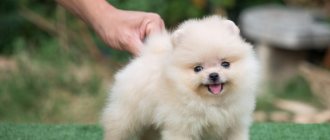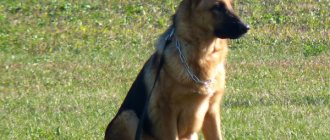Types of training
By nature, Spitz dogs are obedient and smart dogs that are easy to train and accustom to different commands.
Training a Spitz at home is an important point in raising an intelligent and obedient dog. There are different options for how to train a puppy, so even if you have problems with having free time for training, do not leave the situation to chance. Choose one of the training options:
Dog training
- individual lessons with a dog handler;
- joint training with a trainer;
- independent exercises with a Spitz.
Lessons with a dog handler
These lessons are conducted by experienced dog handlers directly in private with your pet. Such training will help you avoid mistakes when raising an adult, obedient dog, but it is better to start them from an early age. Upon completion of training, you will receive a well-mannered trained Pomeranian.
The dog trainer will not only teach the puppy a course of basic commands - “Voice!”, “Lie down!”, “Place!”, “Sit!”, “Face!”, “Paw!”, but will also prepare the future winner of exhibitions.
Naturally, there are disadvantages to such training:
- high cost of canine services;
- long separation from your pet;
- subsequent adaptation.
Dog handler
Joint training
To raise a Spitz that will not only be obedient, but also easily make contact with you, joint training with a dog handler will help. This option is the most reliable. It will allow you to get the most useful information on raising a pet and an excellent result upon completion of training.
The principle of this training is that you and your dog take courses at a canine center under the supervision and guidance of specialists. At the same time, the pet gains experience communicating with other dogs, learns how to dominate and bite, but does not separate from you.
Joint training
Independent studies
If you don’t have extra money for a dog handler, don’t want to be separated from your pet, or don’t have the opportunity to work with a trainer, the option of self-training is perfect.
However, keep in mind that despite the fact that Spitz teams memorize commands quite simply, this option requires a long study of specialized literature and complete dedication from you. But this method is compensated by a strong mutual connection with the pet, obtained during classes and the educational process.
Tips and tricks
To successfully train a Spitz at home, you must follow the following recommendations:
- You should not separate time between playing, socializing and training. If training takes place in a relaxed atmosphere, the pet learns much faster.
- It is unacceptable to resort to violence in training. If the owner fails to reach the Spitz, the owner is to blame.
- A person should not demand too much from a puppy. The trainer teaches the pet commands that are appropriate for his age. If you follow the plan, your Spitz will learn all the basic commands by the age of 5 months. At 1.5 - 2 months, the pet can be taught its name and commands: “place”, “fu”, “no”; at 2-3 months - “come to me”, “sit”; from 3 to 5 months, the puppy can already learn the “voice” and “quiet” commands.
- There is no point in training a baby until 1.5 months. There is a risk that the animal will refuse to carry out any commands due to negative associations.
- Training should take place regularly. Breaks in training contribute to the loss of already developed skills.
- Voice commands should always be the same. Changing the form of a word confuses the puppy.
- It is not recommended to allow your Spitz to follow commands from strangers. If strangers are able to control your pet, it may be stolen.
- When training the “fu” command, it is advisable to teach the Spitz not to take a treat from someone else’s hands. This will protect the baby from the influence of ill-wishers.
- It is important to find an approach to your puppy and have a psycho-emotional connection with him. This will make training easier.
- Strictness is good, but in moderation. All commands must be pronounced in a calm, even voice. The exception is commands that require an immediate response: “ugh”, “come to me”. They should be pronounced with a note of severity.
- Dogs, like people, have distinct personalities. Each puppy has its own behavioral characteristics. When training, it is necessary to take into account the character and temperament of the Spitz. If the owner does not feel his Spitz, training may not work.
Compliance with the above tips and recommendations will allow the owner to raise a Spitz puppy without any problems, without resorting to the help of specialists in the field of cynology.
Despite the complexity of training at home, it is a very useful experience for establishing a psychological connection between a person and a dog. If the owner personally controls the behavior of his pet, he is confident in the quality of training and knows all the strengths and weaknesses of his puppy. This allows you not to worry about your pet’s behavior in an unexpected situation. A well-mannered dog will not cause inconvenience to either the owner or society.
Where to start training
There are basic rules that should be followed when training:
- Regularity of classes. You should not take breaks in training, because even a minimal deviation from the schedule can slow down the educational process and disrupt your pet’s mood.
- Repetition of covered material. At the beginning of each training session, reinforce the old commands your dog has learned. Don’t rush into new ones if you see that there are gaps in the knowledge you’ve already acquired.
- Patience. A small puppy may make mistakes at first, so be patient and don't rub his nose in every mistake.
- Alternating “carrot and stick”. Any training cannot do without praise and punishment, but do it wisely. Praise your pet even for small successes, but do not forget to show displeasure after his mistakes.
- No overexcitability. Conduct classes in places where there will be no distractions for your pet. If you are training your puppy outside, find an empty area where there are no other animals or external stimuli.
Follow the basic rules during training and training your Spitz will be enjoyable for both you and your pet:
- win the puppy's love;
- get rid of the negative aspects of this breed, make sure that the puppy does not bark in vain or show aggression towards other animals;
- do not demand the impossible, start with simple commands;
- use different intonations when teaching voice commands, be strict in your voice when teaching prohibition commands, such as “Fu!” and “You can’t!”;
- do not change the command names familiar to the dog;
- do not allow commands to be executed that were not given by you;
- integrate verbal and nonverbal cues.
When to start
Spitz training must begin at an early age. When a puppy gets into the house, he should be told what he can do and what he can’t do. It is customary to reward people for good behavior, but scold them for misbehavior or deprive them of entertainment.
How long do Pomeranian Spitz live at home?
The sooner the owners begin raising the dog, the easier and faster the socialization process will be. A trained Spitz barks only on command, reacts to the words “sit” and “next”, and knows its nickname.
For your information! Regular training will help you find harmony and peace in your family with your dog.
Basic Commands
Any trained dog is distinguished by unquestioning obedience, which arouses respect and admiration from the people around him. Additional skills are good, but initially you should give preference to learning the basic commands.
Training should begin with teaching basic commands.
Dog handlers include the following basic commands:
- "Name". First of all, the puppy must learn its name. To avoid problems, there is no need to use intricate names; the simpler the name, the easier it will be for the pet to learn it.
- "Ugh". This word means danger in the language of dog handlers. That is why use it when the puppy tries to eat a suspicious object. Accompany the word with strict intonation and tight tension on the leash.
- "It is forbidden". Pronounce this word clearly with a firm intonation that does not accept objections. It has a different meaning from "Fu". It is used to immediately stop actions that are undesirable for the owner: the dog begins to bark for no reason, beg, dominate and perform other actions for which it has not received permission.
- "Place". Before you start studying, organize your pet a personal corner. Only then explain the meaning of the command. After saying the word for the first time, take the Spitz to its place and praise it.
- "To me". Say this command in a confident voice and at the same time tighten the leash. When a response occurs, praise the dog.
- "Sit". The most important stage of learning during the transition between light and heavier signals. It is this command that helps create a disciplined dog. Place your pet at your side, holding it on a short leash, say its name and this command. Then lightly press on the puppy’s rump and pull the leash back and up. Don't forget to praise your pet when it's successful and give him a treat.
- "Near". A command that allows the owner to feel comfortable when there are crowds of people. After saying the word, pull the leash so that the dog comes close to your left leg. If your Pomeranian speeds up or tries to change direction, repeat the word and action. Reward obedience.
“Voice!”, “Wait!”, “Aport!” and other words, learn when the puppy has reached six months of age and has mastered a full set of basic commands.
We continue to educate
The puppy must know its name well. To do this, always call him by name when praising him. Little Pomeranians remember their names very quickly.
Even if you do not plan to participate in any competitions, your dog should know the basic commands. The basics of discipline will come in handy on a walk, or when meeting unfamiliar dogs and people. Let's look at how to raise a Spitz to be obedient:
- Command "Give!" It is easiest to learn while playing with a ball. When the dog brings the ball, before picking it up, say “Give!” and praise your pet.
- Command “Come to me!” is also quickly remembered by the dog. During a walk, when the puppy is not playing with anything, call “come to me.” He will look at you, do not approach, but lightly pull the leash and repeat the command. Speak in a soft, calm voice and be sure to praise when appropriate.
- Team "Ugh!" and the command “No!” scare the dog. Therefore, puppies that are six months old can be trained to use them. Say sharply and intimidatingly: “Ugh!”, then immediately jerk the leash. During training, make sure that the leash is not between the paws and does not injure the dog.
- The Pomeranian easily learns the “Nearby” command. When walking, lead your puppy on a short leash to your left. At the moment of changing direction, lightly pull on the reins, while saying the dog’s name and the command “Near”. Speak in a calm voice and do not pull hard on the leash.
- The “Place” command is remembered by the puppy in the first two months of its life. Usually, after eating, the baby goes to his place and goes to bed. Pet him, praise him and say, “Spot.” If the puppy is going to lie down in the wrong place, say the command and take him to his place. The baby should feel protected in his place, then he will learn this command faster.
All commands should be pronounced in a calm, gentle voice so that the animal does not perceive them as punishment.
And after fulfilling the order, the puppy must receive a reward in the form of treats and praise. marks treatment urine persistence food training
How to stop a Spitz from barking
The main negative feature of the cute Spitz is barking, so it is important from a young age to control not only this manifestation, but also the volume.
First determine the cause:
- joy;
- fear;
- aggression or something else.
To distract your Spitz from barking uncontrollably, use:
- toys;
- muzzle;
- water splashes.
Under no circumstances should you distract your pet from this activity with treats. He will take this as praise, which will ultimately have a negative impact on his upbringing.
To wean your pet from a bad habit:
- ignore it, showing dissatisfaction with the sound made;
- scold without using corporal punishment;
- take at least an hour and a half walk so he can burn off his energy;
- use the words “You can’t!” and “Place!”, do not forget to praise the dog for following commands.
How to toilet train
Despite the fact that the Spitz dogs taken from the nursery are potty trained, they will still have to deal with this issue in the new place. Follow these rules and you will succeed:
- remove carpets from the floor to avoid damage;
- buy disposable diapers, put them in a certain place and when the puppy tries to go to the toilet, move him to the diaper, praising him if he succeeds;
- in case of “accidents”, do not scold or punish the baby, he must get used to the new rules.
When your pet is used to the diaper, place a tray in this place and put a “used” diaper so that he makes an association with going to the toilet and a new item for this task.
Pomeranian in a diaper
Gradually move the tray closer to the toilet until it is inside.
Command training
How to teach commands to a Spitz is a question that worries many owners. There are certain algorithms with which you can train a dog without special training or the help of dog handlers.
Nickname
The nickname must be simple and short. The puppy is called by name from the first day of being at home. At the same time, at first it is not advisable to distort the nickname or shorten it. The easiest way to train a puppy is to call him before feeding, walking or during play. For obedience, you need to reward your pet with a treat.
"Ugh" and "no"
The commands “fu” and “no” mean prohibition. You can train on a treat that is placed in front of your pet. When the dog reaches for it, you need to slightly pull back the leash and say the command.
Note! This order can be practiced if the dog starts barking just like that, or jumping on a human bed or table.
"To me"
It is best to teach this command on the street. The owner moves away from the pet the entire length of the leash and says “Come to me.” If the animal does not pay attention, you need to slightly pull the leash towards you. It is necessary to repeat the training until the puppy begins to approach on his own.
"Give"
Convenient to practice during games. Your favorite Spitz toy is suitable for this. When the dog takes it into his mouth, the owner pronounces the command loudly and clearly. If the Spitz gives up the toy, he is rewarded with something tasty.
"Near"
At the same time, you need to say the command and pull the leash towards you so that the puppy stays near your leg. If the dog begins to accelerate or moves to the side, the action is repeated.
"Place"
To learn this rule, the dog must have its own corner in the house. The owner takes the puppy to the bed, moves away and then says “Place!” Every time the Spitz tries to escape to another place, it should be returned to the bedding and the command repeated. When the dog begins to obey, it should be praised and given a treat.
"Voice"
This command helps train your dog to bark only for business. To do this, you need to take a treat and let your pet smell it. Then the owner raises his hand up and pronounces the command. When the Spitz barks, he is given a reward.
"Stand"
Step-by-step team training:
- The dog is placed next to the owner's leg.
- A command is pronounced, after which the Spitz is raised.
- You need to keep your pet in a standing position for 5-10 seconds.
After correct execution, it is necessary to reward the Spitz. The dog should be able to remain in a standing position until the owner allows it to move on.
"Bow"
This team is recommended to train animals from 6 months. Step-by-step instruction:
- A treat is placed on the floor.
- When the Spitz begins to lie down, the owner puts his hand under the belly and lifts the croup. The dog should remain with its front legs extended and its hind legs raised.
- The command is pronounced, then reinforcement is given.
"Aport"
First, the skill is trained on puppies in game mode. From 6-7 months you can try a more complex option:
- A long leash is attached to the collar.
- The Spitz is planted near the leg.
- A stick or toy is thrown a short distance.
- They pronounce a command, after which the dog must approach the object and take it in its mouth.
- The command “come to me” calls the dog back to its place.
- The toy is taken away and a treat is given.
If you have any questions, you can seek help from other breeders or dog handlers
"Quiet"
This command is taught along with the voice. First, the pet barks at the sight of a treat, after the command “quiet” you need to close its mouth with your hand. If the Spitz continues to vocalize, then no reward is given.
"Sit"
The dog should be placed next to you on a small leash. The owner calls the pet's name and then voices the command. During the first couple of steps, you need to lightly press the dog’s sacrum so that it sits down.
The dog must remain in this position until the owner allows him to change position.
"Lie"
This rule is taught after the command “sit”. The dog must be in a sitting position so that the owner presses on the withers and pulls the leash down. When the dog assumes a lying position, a treat is given.
Important! All actions with the dog must be practiced without sudden movements.
"Give me your paw"
This command must be taught in this way:
- They hold their paw in their hand and voice the command.
- Rewards are given after completion.
- Then they exchange one paw for another and say “give me another paw,” while raising the desired limb.
Tips from dog handlers for self-study
If you decide to start raising a Pomeranian on your own, dog experts advise adhering to the following rules:
- consider the character of the pet;
- if difficulties arise, seek help from specialists;
- do not make concessions or exceptions to the established rules for your Spitz;
- Walk your pet daily to release its energy;
- avoid physical punishment;
- engage in social adaptation of your pet;
- do not separate play and learning;
- control barking;
- do not succumb to provocations from the animal and do not allow it to dominate.
In training
Once you have acquired such a beauty as a Spitz, don’t put your upbringing on the back burner. Follow the recommendations of specialists and remember that the future character of an adult dog and the quality of your life together depend on the quality of training.
How to properly train a Spitz at home?
To learn how to train a Spitz, you don’t have to turn to specialists. To do this, it is enough to know and be guided by the main principles of training:
- Form of the game. To prevent training of a Spitz from getting boring and boring, it should be done in the form of a game. While playing, your pet will want to learn more and more commands.
- One-on-one. If there are strangers at home during training, the Spitz will be distracted by them and will not remember the commands.
- Regularity. Caring for your Spitz should always be regular and routine. Training is no exception. After all, how can you teach a Spitz commands if at this time he is out of habit thinking about a walk or rest?
- Who is the head in this house. Spitz categorizes all family members according to authority. He will be happy to obey some masters, but he will be afraid of others or simply show them his reluctance to learn.
- Encouragement. For every completed command, or good attempt, the Spitz needs to be rewarded.











